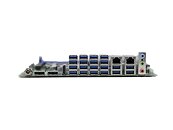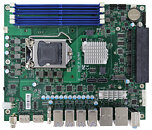- Joined
- Aug 19, 2017
- Messages
- 3,000 (1.07/day)
Have you ever felt the need that your motherboard needs more ports? Different peripherals can occupy quite a lot of USB ports and almost fill up all of them quickly. That is where the Portwell PEB-9783G2AR motherboard comes into play. Being built on Intel's latest W480E/Q470E chipset designed to accommodate any 10th generation 10 core CPU with a TDP of up to 80 W, the board can run either a Xeon W CPU or regular Comet Lake-S Core CPU. However, what makes this board unique is not its chipset or anything, it is the number of USB ports present.
Portwell has put an astonishing 20 (you read that right) USB 3.1 Gen1 ports on the board, which you can run at a full 5 Gbit/s data signaling rate at the same time. The board doesn't use any splitting technology so you are getting the full bandwidth. To get that many ports to run at full capacity, Portwell has presumably re-routed chipset lanes for SATA 3 connectors and used them for USB ports, leaving only two SATA 3 ports. The board is built for the FlexATX form factor and features a sideways PCIe 3.0 port. Being built for Xeon, the board also features support for ECC memory and up to 128 GB of it. While the pricing is not yet available, you can get a quote on Portwell's website.


View at TechPowerUp Main Site
Portwell has put an astonishing 20 (you read that right) USB 3.1 Gen1 ports on the board, which you can run at a full 5 Gbit/s data signaling rate at the same time. The board doesn't use any splitting technology so you are getting the full bandwidth. To get that many ports to run at full capacity, Portwell has presumably re-routed chipset lanes for SATA 3 connectors and used them for USB ports, leaving only two SATA 3 ports. The board is built for the FlexATX form factor and features a sideways PCIe 3.0 port. Being built for Xeon, the board also features support for ECC memory and up to 128 GB of it. While the pricing is not yet available, you can get a quote on Portwell's website.


View at TechPowerUp Main Site






